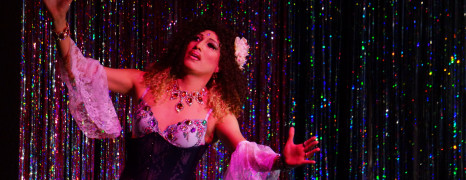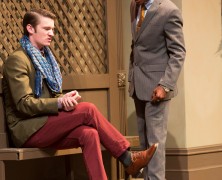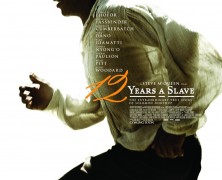Tikia “Fame” Hudson’s production of Ntozake Shange’s For Colored Girls is a rare theater-going experience. Audiences can see the show on March 8 at Warehouse 21.
Jewel Box Cabaret
posted by Charli Renken
Jackalope reviews Jewel Box Cabaret’s Valentine’s performance.
Art Thrash Triumph
posted by Luke Henley
The incongruities in the music world are often what make it so fascinating to follow. The common complaint that “everything has been done before” rings increasingly less true as smaller boutique labels and bands capable of easy self-distribution harbor a broad field of forward-thinking bands and the strange outliers of countless mutated genres. This is why a thrash metal release can still excite and challenge in 2014. Oozing Wound’s new album Earth Suck is not simply a retread of sounds by a bunch of guys who never threw out their Master of Puppets tees. With the debut of its sophomore album it is clear that the band has reached a new level of confidence. While Oozing Wound’s debut album Retrash had a driving pulse and a furious center, there were just as many ideas that felt as disposable as the plastic cups its party vibe seemed to evoke. Even simply judging from the surreal, destructive and muscular album art of Earth Suck—sans any identifying text—the suggestion is that the band is taking a more powerful stance. The results are as crushing as the several-fisted force suggested on the cover. There is a leanness to the sound of these songs, heavily owing to the high treble frequencies throughout. While drummer Kyle Reynolds’ drums bring a palpable rumble throughout, bassist Kevin Cribbin’s playing remains in a similarly high register as Zack Weil’s buzzing guitar. This is not the often fatter heavy sound of most modern metal bands and the feeling of hearing a power-trio awash in the tinny echo of garage-like acoustics brings a weird charm to what could otherwise threaten to fall into the hammy sound of a more tribute-minded act. With tracks like “Genuine Creeper,” however, the formula of traditional thrash tropes is subverted...
Go here: Iconik
posted by Sandra Schonenstein
This semester, Jackalope staff member Sandra Schoenenstein will regularly profile interesting and accessible off-campus spots for students. This week’s pick is Iconik Coffee Roasters.
Character Counts
posted by Nick Martinez
The real joy in Our Lady of 121st Street is taking a peek into these awful people and their regret-filled lives. Even the successful characters are melancholic and searching for hope.
Long View
posted by Nick Martinez
In telling the horror show of slavery, 12 Years doesn’t flinch. Families torn apart, slaves whipped and women raped; the scenes are there, but the brutality of what you witness remains hours, days after you leave the theater.
Middletown Delivers
posted by Nick Martinez
Middletown, the latest SFUAD Performing Arts Department production, opens with Curtis Williams’ Public Speaker waxing philosophic about the nature of small towns. It’s a fun digression that captures the high energy and inherent sadness of the mostly plot-less but emotionally poignant show that follows. The play has an ensemble cast, but there are a few characters given the most time to shine, including: Mathew Eldridge’s John Dodge; Porscha Shaw’s Mary Swanson; Michael Phillip Thomas’s Cop; and Jade Lewis’s Mechanic. Eldridge and Shaw did a phenomenal job carrying the emotional weight for much of the play. Due to the structure of the play, many of the actors had the difficult job of taking what could easily be one-note characters and adding pathos. It seems lazy to make such a blanket statement, but the whole cast was really up to the challenge. Not every joke landed, and not every character left the same impression, but the batting average is so high, it is easy to brush off the shortcomings. Maia Rychlik’s Librarian and Yusef Seevers’s Doctor, in particular, breathed such life into simple characters that leave one combing through all of their dialogue for hidden meaning long after you leave Greer Garson Theatre. The two scenes that stood out most were the scene in space and Lewis’s scene with Tallis Geohegan-Freifeld’s Doctor. The scene in space, featuring Matt McMillan and Robert Henkel Jr. is nestled towards the end of Act One. The scene is by far the most removed from the plot, but is the first point where the themes are front and center. McMillan and Henkel Jr.’s subtle performance prevents the message from being overbearing. Chelsea Kuehnel’s sets are also a delight in their simplicity, giving the space scene a magical feel and the dusty...
All ‘Bad’ Things Must End
posted by Nick Martinez
“Guess I got what I deserved,” sang Pete Ham from Badfinger’s 1971 single “Baby Blue,” over Breaking Bad’s final moments. And despite Walter White’s final string of mini-victories, his death was the only proper conclusion. “Felina” opens back in New Hampshire with Walt trying to steal a parked car. Police lights shine from behind and for the first time in memory Walt prays for the chance to get back to the ABQ. The police leave and through divine intervention the car keys slip from the visor. Walt starts the car, Marty Robbins’s “El Paso” blares from the stereo, and for the last time, audiences hear the opening theme. Fans were worried leading up to the finale, having felt wronged by show-runners before (Damon Lindelof’s Lost, David Chase’s The Sopranos), but having seen the episode twice now, I feel that there is only one word to describe Breaking Bad’s finale: perfect. Vince Gilligan, and his team of merry writers, were able to produce a finale that was both thematically and structurally pleasing. Some have argued that storylines were wrapped up too neatly, but I would argue in the age of cut to blacks, and lumberjacks, true closure is refreshing. The standout moment of this episode has to be Walt’s scene with Skyler. Set in her new dingy apartment, Skyler tells Walt he has five minutes to talk. Walt gives Skyler the GPS coordinates that will lead the DEA to Hank and Gomez, hoping that the coordinates will be a good bargaining chip to get her off the hook. He also starts to tell her why he did what he did. “Stop, if I have to hear one more time that you did this for your family-” says Skyler. “I did it for me,” Walt says to a stunned Skyler. “I like it. I was good at it. And, I was really… I was alive.” One of Walt’s defining characteristics throughout the show was his inability to face the truth. To justify all of his actions, regardless of their moral depravity. But in the moment where he finally tells the truth, for Skyler, as well as the audience, there is relief. In no way was Walt redeemed; he’s caused so much pain and destruction to those around him to ever be redeemed, but it completes the tragic series of events. The hero finally recognized he was the villain. There was plenty of relief this episode for fans. Walt blackmails Gretchen and Elliot into leaving Walt’s $10 million into a trust for Jr.; with the help of Badger and Skinny Pete (“I don’t know, this all seems kind of shady, like, morality wise.”); Walt uses Chekov’s Ricin against the ever-deserving Lydia; Walt’s rigged M60 takes down Uncle Jack’s (Michael Bowen) entire Neo-Nazi crew; Jesse strangles Todd with his own chains; and Walt kills Uncle Jack in a masterfully similar way that Uncle Jack killed Hank in Ozymandias. Jesse’s refusal to shoot Walt in the end was a fitting conclusion to his arc. He finally refused to do Mr. White’s bidding. The final shot of his screaming and crying, blazing out of the Neo-Nazi compound, was the perfect mixture of happiness, shock, anger and relief. As a long time fan, I was happy that there was no trip to Belize. In the end, Breaking Bad is Walt’s story. His casual stroll through the Neo-Nazi meth lab, lovingly caressing his tools, while police sirens blared, was a fitting end to his life. He died with what he loved. I’m a fan of television. My throat dried as Stringer died, my heart skipped a beat when Tony cut to black. But, without a single doubt in my mind, Breaking Bad is the greatest television series of all...









 Jackalope Magazine is the student magazine of Santa Fe University of Art and Design. Building on the interdisciplinary nature of our education, we aim to showcase the talent of our university and character of our city.
Jackalope Magazine is the student magazine of Santa Fe University of Art and Design. Building on the interdisciplinary nature of our education, we aim to showcase the talent of our university and character of our city.
Recent Comments